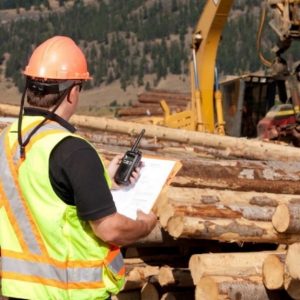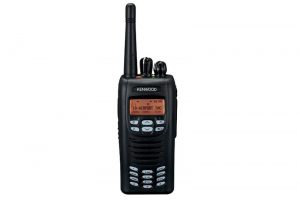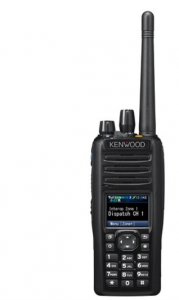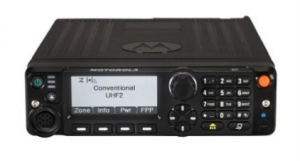Curious about dust-proof and waterproof two-way radios?
CONTACT US
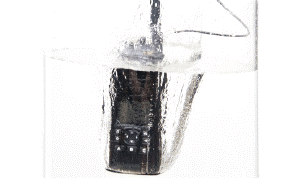 With an IP Rating of 68, this NX 5000 Series portable radio from Kenwood is completely protected against dust and can be immersed in 1 metre of water for up to two hours.
With an IP Rating of 68, this NX 5000 Series portable radio from Kenwood is completely protected against dust and can be immersed in 1 metre of water for up to two hours.
The picture to the left shows this radio being tested by being placed into a Ziplock bag filled with water. This is unlikely to happen in everyday use, but if it falls into a bucket, a puddle or a lake, an IP Rating of 68 means your radio is built to stand up to the immersion without any loss in performance.
When choosing two-way radios for your team, you need to know you are using one that can hold up in the tough conditions of your work environment and provide communication when you need it the most. Claims of ‘waterproof’ or ‘dustproof’, provide varying degrees protection, so it’s important to consider the environment your crew will work in and choose a radio with an IP Rating that matches those conditions. So, let’s talk about that.
What are IP Ratings?
The “IP” in IP Rating stands for “Ingress Protection” and it describes the extent to which your radio is protected from solids (like dust) and liquids from entering the radio casing and damaging or destroying internal components. The IP Rating system was developed by the International Electrotechnical Commission (IEC), which is an international collective of academics, industry experts and electrical engineers.
How the System Works
IP Ratings consist of two digits; the first (ranging from 0 to 6) identifies the level of protection from solids and the second (ranging from 0 to 8) defines protection from liquids or moisture. Check the chart below for a clear breakdown of the ratings.
Ingress Protection (IP) Rating System
| Solids (First Digit) | Liquids (Second Digit) | ||
| 0 | No protection. | 0 | No protection. |
| 1 | Protection from objects greater than 50 mm. | 1 | Protected against dripping water or condensation. |
| 2 | Protection from objects greater than 12 mm. | 2 | Protected from water spray 15 degrees from vertical. |
| 3 | Protection from objects greater than 2.5 mm | 3 | Protected against water spray 60 degrees from vertical. |
| 4 | Protection from objects greater than 1 mm. | 4 | Protected against water spray from all directions. |
| 5 | Protected against large dust particles. | 5 | Protected against low-pressure jets of water. |
| 6 | Totally protected against dust. | 6 | Protected against temporary flooding. |
| 7 | Protected from immersion from 15 cm to 100 cm. | ||
| 8 | Protected against long periods of immersion. |
Some Typical Environments
Construction Sites and Forestry Camps
Logging camps and construction sites are typically dirty and dusty environments. Given that you’re working in the outdoors, there’s a good chance you’re going to get wet, too (rain, puddles, bodies of water, you name it). Because of this, you’ll want a two-way radio with a high dree of dust-proofing (either a 5 or a 6) and a waterproof rating of 6 or higher.
Remember to consider IP Ratings for mobile radios as well as portables. Water is unlikely to get on your mobile radio unless you’re cleaning your truck, but dust can easily get into the cabin. Because of that, a dust-proofing rating of 5 or 6 will go a long way, while a waterproofing rating of 5 could be adequate.
Hospitality, Education, and Retail
By comparison, hotels, college campuses and retail outlets are drier, cleaner environments. While dust and water can still enter the radio housing, the odds of that happening are lower than they would be on a construction site or a forestry camp. Because of this, an Ingress Protection rating of 54 may be enough.
Let’s Check out Some Radios
 Kenwood NX-200G/300G NexEdge VHF/UHF Portable Radio
Kenwood NX-200G/300G NexEdge VHF/UHF Portable Radio
This portable handheld from Kenwood has an IP rating of 54/55, meaning it has significant protection against dust and can handle low-pressure water jets or sprays from all directions. In practice, that means you can use it in a dirty dusty environment, like a construction site or a manufacturing plant, and if you use your radio in the rain, it’ll still transmit and receive. For more information on the specifications of this Kenwood radio, just click the image to view the technical specifications in our product catalog.
 Kenwood NX-5000 Series
Kenwood NX-5000 Series
These Kenwood radios come with IP ratings ranging from 67 to 68. In other words, they are fully dustproof and have a high degree of waterproofing and protection from immersion in depths ranging from 15 cm up to 100 cm (or 1 metre) depending on the model. This is actually the radio you saw fully immersed in water at the top of this article.
If you’d like more information on the Kenwood NX-5000 series, click the image or contact us.
Motorola APX™ 8500 All-Band P25 Mobile Radio
The APX 8500 mobile from Motorola offers an IP 56 rating. That means it has an excellent level of protection against any dirt and dust that may enter your vehicle, as well as withstanding jets of water. But the excellent level of Ingress Protection only scratches the surface of the benefits this P25 mobile has to offer. To learn more about its technical specifications, click the image or contact us.
If you ‘re wondering which radio would be suitable for your project and job site, get in touch with us. We’d be happy to answer your questions and build the most effective solution.
Tridon is a full solution Telecom Systems Integrator with CSA certification and licensed by APEGA. Our Engineering, Service and Tower Divisions collaborate with customers to build engineered solutions including communications systems design, tower inspections and co-location, wireless broadband, fiber optic cabling, site security, and two-way radio communication.

